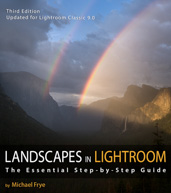Vision and Creativity
by Michael Frye | Dec 1, 2013 | Vision and Creativity
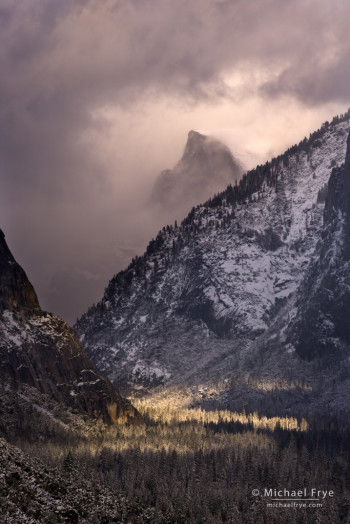
Half Dome and Yosemite Valley from Tunnel View, Yosemite NP, CA, USA
In a recent post I talked about adapting your composition to the light, rather than hoping that the light adapts to your composition. Nowhere is this more true than at Tunnel View. Sometimes the classic view – with El Capitan on the left, and Cathedral Rocks on the right – works perfectly. But not always. When I made this photograph the most interesting part of the scene was a small area in the distance where the light was hitting Half Dome and the valley floor below, so I zoomed in with my 70-200mm lens, turned the camera to a vertical orientation, and filled the frame with just those two spots.
Looking at this photograph made me think about clearing storms, and snow, and Christmas coming. I hope we get lots of snow this winter, not just for the sake of photographers, but for everyone in California. We’ve had two straight years of meager precipitation here, and we really need a wet winter. So let it snow!
— Michael Frye
Related Posts: Courting Luck: How to Take Advantage of Special Light and Weather in Landscape Photography; Courting Luck, Part 2: Adapting Your Composition to the Conditions; A Beautiful Week in Yosemite
Did you like this article? Click here to subscribe to this blog and get every new post delivered right to your inbox!
Michael Frye is a professional photographer specializing in landscapes and nature. He is the author or principal photographer of The Photographer’s Guide to Yosemite, Yosemite Meditations, Yosemite Meditations for Women, and Digital Landscape Photography: In the Footsteps of Ansel Adams and the Great Masters. He has also written three eBooks: Light & Land: Landscapes in the Digital Darkroom, Exposure for Outdoor Photography, and Landscapes in Lightroom 5: The Essential Step-by-Step Guide. Michael written numerous magazine articles on the art and technique of photography, and his images have been published in over thirty countries around the world. Michael has lived either in or near Yosemite National Park since 1983, currently residing just outside the park in Mariposa, California.
by Michael Frye | Nov 26, 2013 | Composition, Photography Tips, Vision and Creativity
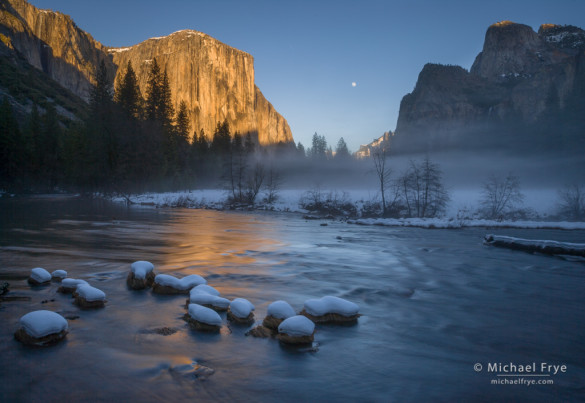
Moon rising between El Capitan and Cathedral Rocks from Valley View. What’s the least interesting part of this image?
The best compositions are simple; they present only the essentials, and leave out extraneous clutter. The most common mistake in photography – by far – is including too much in the frame. Anything that’s not adding to the photograph’s message is detracting from it.
To help simplify your compositions, ask yourself, before you press the shutter, “What’s the least interesting part of this photograph?” Try to identify the weakest area of your composition, and find a way to get rid of it. Then, once you’ve done that, ask the same question again: “Now, what’s the least interesting part of this image?” And get rid of that. And keep doing that until there’s nothing left that you could possibly cut out without losing something vital.
To give you some practice, look at the photograph above. What’s the least interesting part of that image? And if you got rid of that, what would be next – what’s the next least interesting part of the photograph?
I’ll give you a minute to think about it. When you’re ready, take a look at this next photograph, and answer the same question: what’s the least interesting part of this image?
(more…)
by Michael Frye | Nov 19, 2013 | Composition, Photography Tips, Vision and Creativity
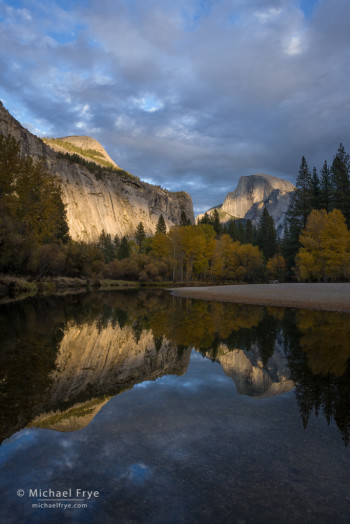
Half Dome and the Merced River, 4:28 p.m.
Is it better to be active or static? To change your location and composition to suit the light, or hope that the light changes to suit your composition?
There’s this persistent myth that Ansel Adams would camp for days at one spot, waiting for the right light. Ironically, this myth is often repeated in relation to Clearing Winter Storm, which was made at Tunnel View, only a few miles from his warm home and comfortable bed in Yosemite Valley. In fact Ansel wrote, “I have always been mindful of Edward Weston’s remark, ‘If I wait for something here I may lose something better over there.’ I have found that keeping on the move is generally more rewarding.”
I have also found that keeping on the move is more rewarding. I’ve sometimes regretted moving, but more often regretted staying when I ignored the inner voice that told me the light would be better elsewhere. And when I do find myself in the right place at the right time, I’ve found that it pays to stay active with my camera and my compositions, and not get lazy about changing lenses or camera positions. If I decide in advance what my composition should be, and stick with that no matter what, I’ll probably miss some great opportunities.
(more…)
by Michael Frye | Aug 6, 2013 | Light and Weather, Photography Tips, Vision and Creativity
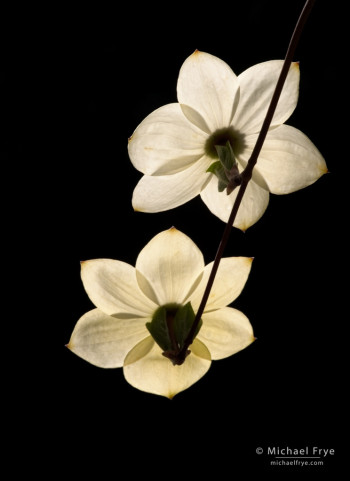
Dogwood blossoms, Yosemite. These backlit flowers stand out cleanly against a dark, shaded background.
Light Against Dark
Many of the most effective photographs share a simple lighting concept: they either place a light subject against a dark background, or a dark subject against a light background.
This first photograph of two dogwood blossoms is a perfect example of a light subject against a dark background. In fact the background isn’t just dark; it’s completely black, so there’s nothing to compete visually with the flowers. The contrast creates a simple and dramatic image.
This light-against-dark situation is what makes photographs of Horsetail Fall so striking when conditions are right. The waterfall stands out because it’s brighter than the surrounding cliffs – and, of course, because of the color.
(more…)
by Michael Frye | Jul 23, 2013 | Light and Weather, Photography Tips, Vision and Creativity
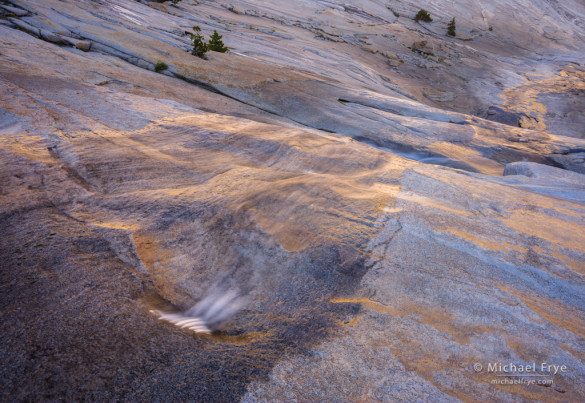
Creek descending through a granite basin. The sun was hitting the rocks just beyond the top of the frame, reflecting the gold color into the water, and even onto some of the polished rocks on the right.
When people think of photographing a reflection, they usually think of a mirror reflection, like a mountain reflected in a tranquil lake. I’ve done my share of those, but I think it’s often more interesting to just look at the colors, textures, and patterns on the water’s surface.
During my just-completed Hidden Yosemite workshop we had many opportunities to photograph reflections of all kinds. The accompanying photographs represent a mini-gallery of reflection photographs that I made during and just prior to the workshop, with extended captions to explain the thought process behind each image. Most of these are not mirror reflections; instead, they’re focused on the water’s colors and textures.
(more…)
by Michael Frye | Jul 10, 2013 | Composition, Photography Tips, Vision and Creativity
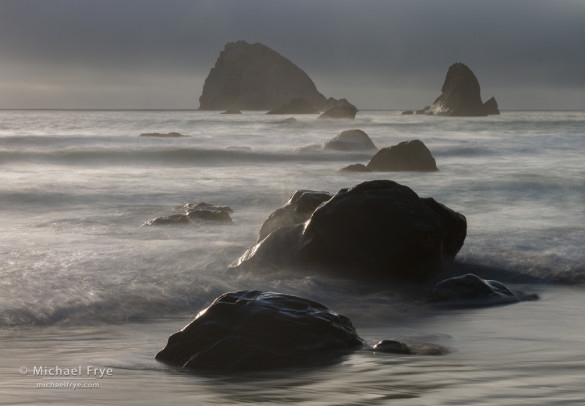
Rocks and sea stacks, late afternoon, Redwood NP, CA, USA
Spacing and separation are always important elements of composition, but during my recent workshops in and around Redwood National Park we encountered many situations where spacing and separation were particularly vital.
The photograph above is a good example. I positioned the camera carefully to avoid, as much as possible, visual mergers between the foreground rocks. I wanted the shape of each rock to stand out clearly, as those shapes are the point of this composition: they set up a repeating pattern, and lead your eye from foreground to background.
(more…)













